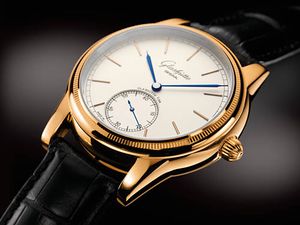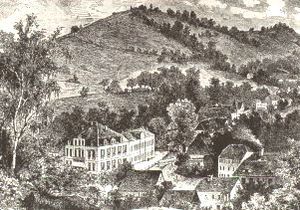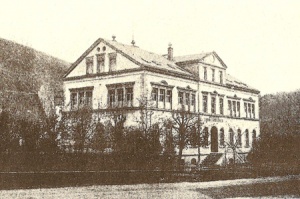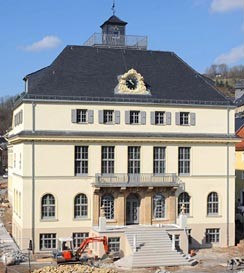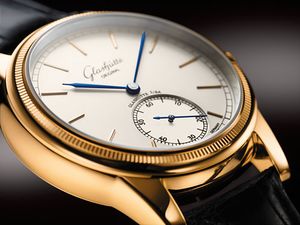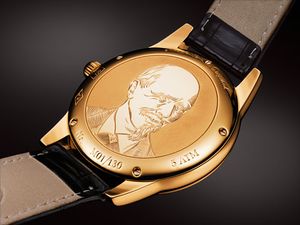1878 – Special Edition Moritz Großmann: Unterschied zwischen den Versionen
| Zeile 22: | Zeile 22: | ||
[[Bild:Glashütter Schuluhr H. van Baal.jpg|thumb|The historical pocket watch Nr. 3824 made by the student of German School of Watchmaking [[Van Baal, Henri|H. van Baal]]]] | [[Bild:Glashütter Schuluhr H. van Baal.jpg|thumb|The historical pocket watch Nr. 3824 made by the student of German School of Watchmaking [[Van Baal, Henri|H. van Baal]]]] | ||
The anniversary model was inspired by the design of historical pocket watches made by students in the 1920s., a timepiece such as this uniquely builds a bridge between the past and the future of Glashütte’s art of watchmaking. Then, as now, they were made as final exams by watchmaker apprentices. | The anniversary model was inspired by the design of historical pocket watches made by students in the 1920s., a timepiece such as this uniquely builds a bridge between the past and the future of Glashütte’s art of watchmaking. Then, as now, they were made as final exams by watchmaker apprentices. | ||
| − | [[Bild:1878 – Sonderedition Moritz GrossmannZB.jpg|thumb|left|Detailansicht des Zifferblattes<br> | + | [[Bild:1878 – Sonderedition Moritz GrossmannZB.jpg|thumb|left|Detailansicht des Zifferblattes<br>The hand arbor is lovingly polished by hand.]] |
| − | + | Just one look at the dial is enough to recognize the fusion, and memories of graceful pocket watches of the past come to life. The silver-plated dial is home to sweep hour and minute displays whose blued and polished sword-shaped hands contrast with the background. Loyal to details, the hand arbor is lovingly polished by hand. Glashütte Original’s designers placed the subsidiary seconds at 6 o’clock, while the minute scale and filigreed markers are placed in perfect harmony around the center of the '''1878 – Special Edition Moritz Großmann'''’s time display. | |
| − | |||
| − | |||
Hinter der schlicht anmutenden Oberfläche des Zifferblattes verbirgt sich ein aufwändiger Herstellungsprozess. So entschied man sich bei Glashütte Original bewusst für die Anwendung einer altbewährten Tradition – der Technik der gekörnten Versilberung – auch l’argenture grainée genannt. | Hinter der schlicht anmutenden Oberfläche des Zifferblattes verbirgt sich ein aufwändiger Herstellungsprozess. So entschied man sich bei Glashütte Original bewusst für die Anwendung einer altbewährten Tradition – der Technik der gekörnten Versilberung – auch l’argenture grainée genannt. | ||
Version vom 1. April 2008, 23:31 Uhr
BASELWORLD 2008: 1878 - Special Edition Moritz Großmann
A Watch with Some History
For watch city Glashütte, located in Saxony’s Müglitz Valley, May 1, 1878, is an important date in history. On this particular day, the German School of Watchmaking in Glashütte was founded on the initiative of watch manufacturer Moritz Großmann.
Rooms from the community school building of the time served as the place of instruction. In its second year of existence, the increasing number of students made building a separate school building a necessity.
With the generous support of the state government, the local authority district, and a foundation the new facility located in the heart of the city was inaugurated.
The picturesque city 130 years later:
thoroughly renovated and refurbished, the former school building will be inaugurated on May 22, 2008, as the historical home of the German Watch Museum in Glashütte.
While on two floors the moving history of Glashütte’s art of watchmaking will be conveyed in a vivid manner, one floor of the renovated building will retain its original function, housing Saxon manufactory Glashütte Original’s own Alfred Helwig School of Watchmaking and continuing to keep Moritz Großmann’s legacy alive.
Glashütte Original’s designers thus created a worthy timepiece in the 1878 – Special Edition Moritz Großmann in memory of the great pioneer Moritz Großmann, who combined the past with the present in a most wonderful way.
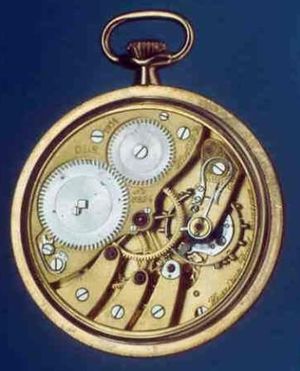
The anniversary model was inspired by the design of historical pocket watches made by students in the 1920s., a timepiece such as this uniquely builds a bridge between the past and the future of Glashütte’s art of watchmaking. Then, as now, they were made as final exams by watchmaker apprentices.
Just one look at the dial is enough to recognize the fusion, and memories of graceful pocket watches of the past come to life. The silver-plated dial is home to sweep hour and minute displays whose blued and polished sword-shaped hands contrast with the background. Loyal to details, the hand arbor is lovingly polished by hand. Glashütte Original’s designers placed the subsidiary seconds at 6 o’clock, while the minute scale and filigreed markers are placed in perfect harmony around the center of the 1878 – Special Edition Moritz Großmann’s time display.
Hinter der schlicht anmutenden Oberfläche des Zifferblattes verbirgt sich ein aufwändiger Herstellungsprozess. So entschied man sich bei Glashütte Original bewusst für die Anwendung einer altbewährten Tradition – der Technik der gekörnten Versilberung – auch l’argenture grainée genannt.
In einem ersten Schritt wird hierfür die Oberfläche des Messingzifferblattes mit einer Mischung aus Wasser, Kreide und Holz maschinell gestrahlt. Im Anschluss daran wird manuell eine Paste, angemischt aus Silberpulver und Wasser, sorgfältig auf die vorbehandelte Oberfläche aufgetragen.
Das Resultat ein puristisch anmutendes Zifferblattbild, das seinen Betrachter durch die raffinierte Oberflächenstruktur in dessen Bann zieht.
Den idealen Rahmen für den dezenten Zeitmesser bildet die kanellierte Lünette. Das 40 mm große Gehäuse der Uhr, erhältlich in Rosé- oder Weißgold, ist mit modernster Mechanik ausgestattet: Dem Automatikwerk Kaliber 100-11.
Ein Saphirglasboden ermöglicht das hochfein vollendete Innenleben der Uhr, mit all seinen traditionellen Bestandteilen der Glashütter Uhrmacherkunst, aus der Nähe zu betrachten.
Den krönenden Abschluss findet die „1878 – Sonderedition Moritz Grossmann“ im zusätzlich mit gelieferten Gehäuseboden angefertigt aus Rosé- oder Weißgold. Diesen ziert eine per Hand angebrachte, aufwendige Gravur, die das Porträt Moritz Grossmanns zeigt.
Lediglich eine limitierte Anzahl von jeweils 130 Stück dieses Zeitschreibers in Weiß- oder Roségold werden weltweit erhältlich sein.
